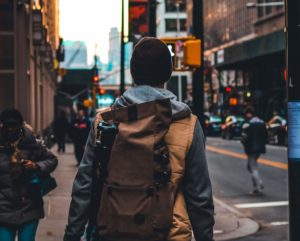Why Inclusive Cities Start with Safe Streets
Universal design aids in making inclusive cities for people with disabilities. New design guidelines from the American Society of Landscape Architects show us how to build them.
BY DIANA BUDDS (VIA CURBED)
The fight for more equitable cities is taking to the streets—literally. New street design guidelines from the American Society for Landscape Architecture (ASLA) articulate why.

A man with his back facing the camera walks through a crosswalk in a bustling city.
Last week, ASLA released universal design guidelines for neighborhoods, streets, parks and plazas, playgrounds, and gardens—a range of scales and projects for which landscape architects are regularly called upon to design. By creating this best-practices guide, ASLA is making it easier for designers from all disciplines, elected officials, and everyday people to understand what an inclusive and accessible public realm looks like. More importantly, the guidelines are a call to action.
“If we want everyone to participate in public life, we must design and build an inclusive public realm that is accessible to all,” the guidelines state. “Public life can’t just be available to the abled, young, or healthy.”
ASLA’s universal design guidelines consider physical disabilities like limited mobility, blindness and low-vision, and Deafness and hardness of hearing; people with neuro-cognitive disorders like dementia and Alzheimer’s disease; those with neuro-developmental disabilities, like autism; and aging people. ASLA defines universal landscapes as accessible, participatory, comfortable, ecological, predictable, multi-sensory, walkable, and predictable.
“Access to public space truly is—and always should be—a civil right,” says Alexa Vaughn, a Deaf landscape architect who consulted with the ASLA on the guidelines. “If we continue to design and plan cities that are inaccessible to certain people, we are committing a serious injustice towards these people. This is about guaranteeing the right to public space to all, regardless of dis/ability.”
Accessible streets are particularly important because streets are so foundational to how people get around.
“They are the arteries of our cities,” Vaughn says. “Increasingly designers are designing more accessibly and sustainably by thinking of pedestrians and cyclists over cars. Designers can take this a step further by thinking of the disabled body in the streetscape.”
The conversation about equity and accessibility in streetscapes often focuses on multi-modal transportation—like redistributing space on car-dominant streets to accommodate pedestrians, public transportation, and protected bike lanes. What comes after “complete streets”—streets that are designed to enable safe access for all users, including pedestrians, bicyclists, motorists, and transit riders of all ages and abilities—is a conversation that has recently animated landscape architecture and urban planning.
Transportation and safety advocates are calling for Dutch-style “woonerfs,” or shared streets, in which pedestrians, bikes, scooters, and cars all share the same space with no separate sidewalks or lanes. As Curbed’s urbanism editor, Alissa Walker, has argued, prioritizing the free flow of people leads to safer, more accessible streets for everyone.
Americans with Disabilities Act (ADA) guidelines for streets are scant and focus on technical elements, like clear paths of travel and curb ramps, for people with physical disabilities. Other interventions, like tactile pavement—raised bumps on curb ramps—and accessible pedestrian signals—auditory cues that tell blind and low-vision pedestrians when it’s safe to cross—are becoming more common, but aren’t ADA requirements for streets. (Tactile cues are required by the ADA on public transportation platforms, however.) The ADA’s guidelines don’t take into account quality of experience, or how pleasant and enriching a place is to use, which impacts people with sensory or mental disorders. A noisy, haphazard street might be merely annoying to some people, but to people with certain disabilities, these qualities might make it severely difficult to use.
Read the full story about Inclusive Cities at article source here.


